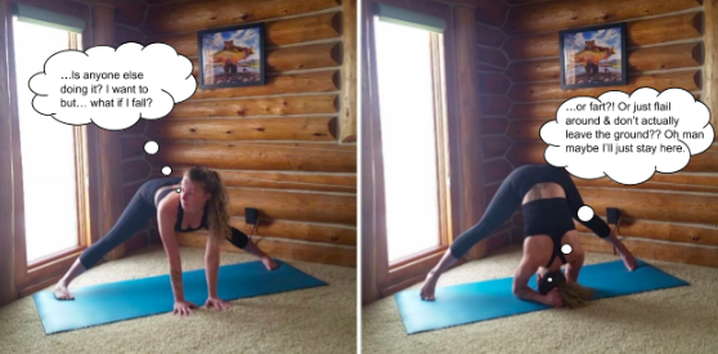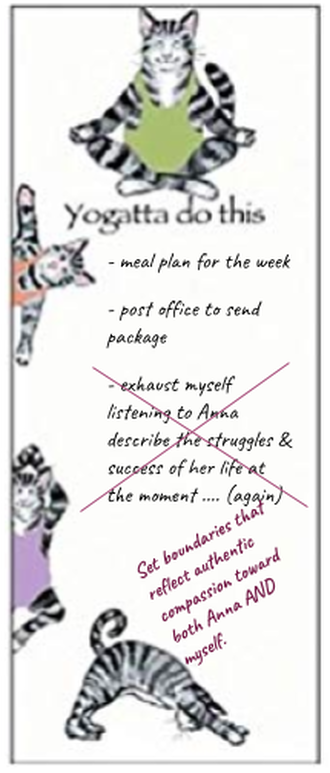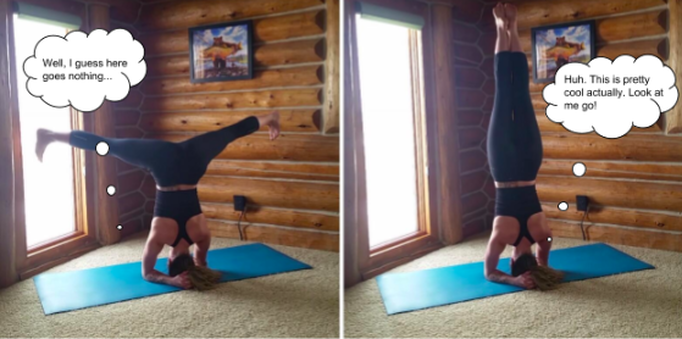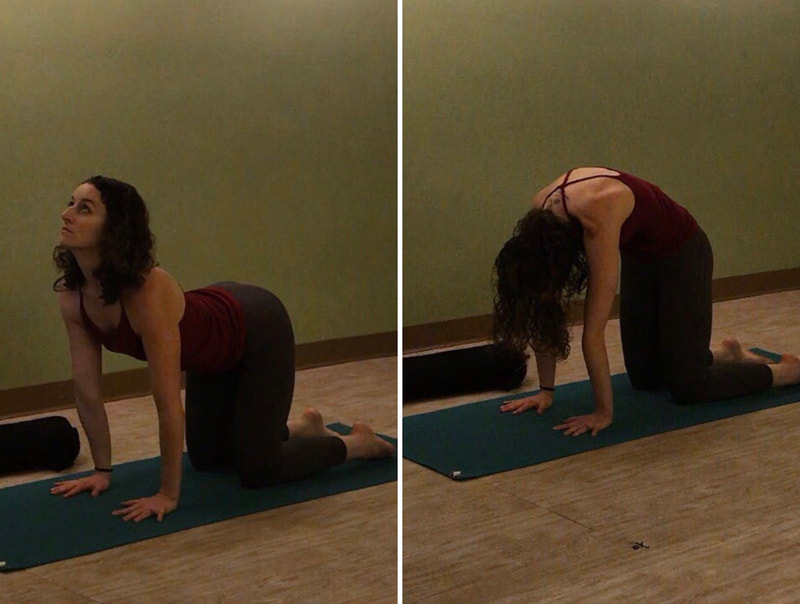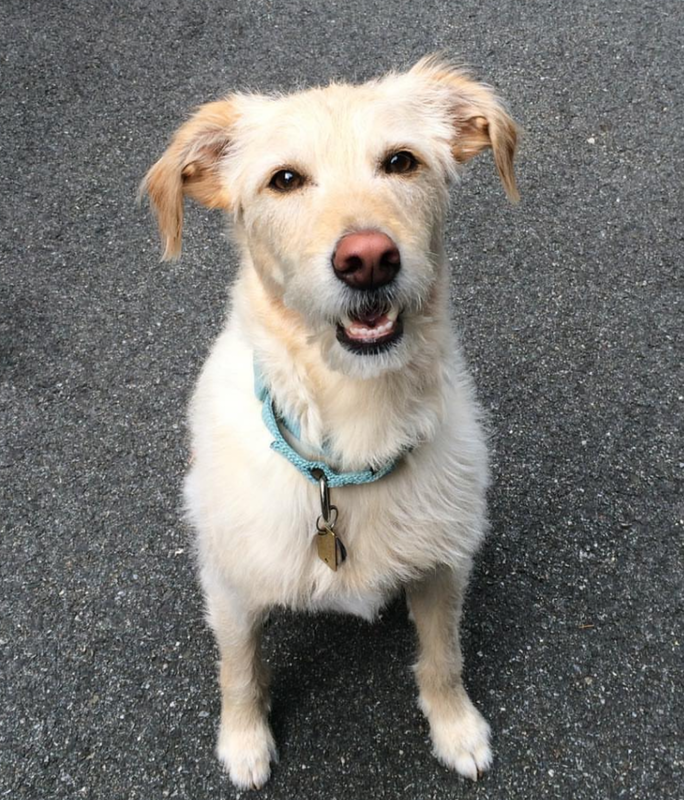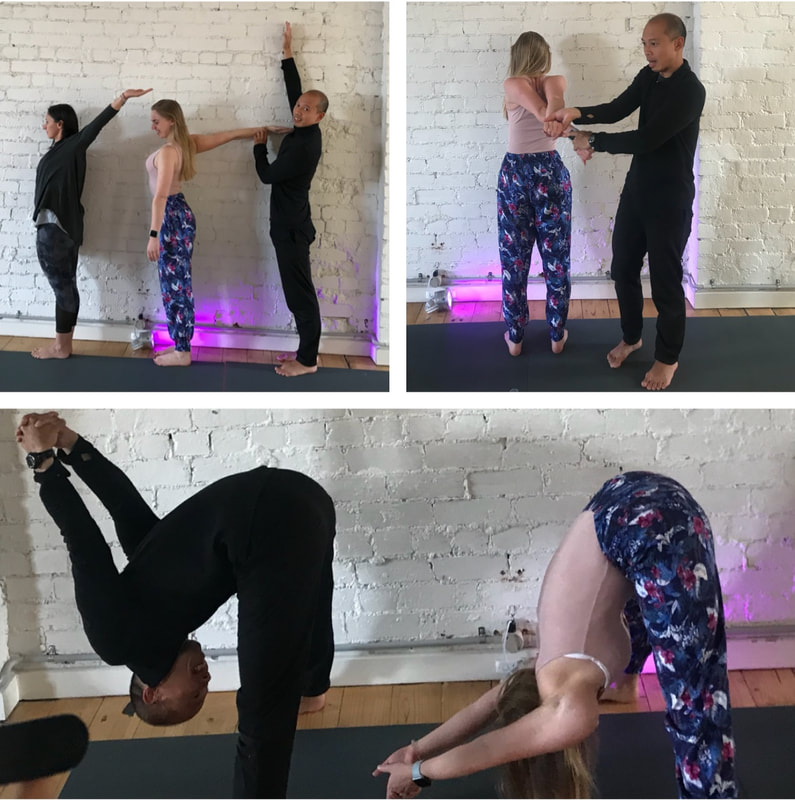Enabling vs Empowering:
Reclaiming Your Inner Power
By Brooke Davidson
You’re in the middle of yoga class and the teacher cues you, from wide-legged forward fold, to plant the forearms, clasp hands together, bring the crown of the head inside the hands, and lean forward to come up into headstand. You’ve been practicing headstand at home against a wall and feel pretty good about it, but as soon as it is cued in class you feel an onslaught of anxious mind-chatter: What if I fall into the person in front of me? What if I can’t get up and I end up just heaving myself around all awkwardly? What if I DO get up, but then I fart in front of the whole class?!... You decide to stay in wide-legged forward fold and maybe try it next time.
We have all been in some version of this situation, and what it comes down to is the distinction between choosing to enable versus empower ourselves.
Categories of Enabling
When we enable, we allow ourselves (or others) to fall into either of the following categories: 1) stay in the “comfortable” or “safe” zones we’ve already explored, or 2) engage in unauthentic and potentially even harmful behaviors.
Often, we take the former path, choosing the “safe” route because it results in a known outcome. In this case, a person comfortable in a pose might ask: “So what’s the big deal? What is so harmful about taking things a bit easy?” In this instance, as with any decision similarly made based on comfort, it is a matter of holding oneself back. If a child was not prepared to push herself a bit, she’d never take the risks necessary in learning to walk. Likewise, if we are not prepared to take risks, we will never grow beyond our current state. While enabling category 1 might seem harmless, it ultimately promotes stagnancy and a general embodiment of fear and low self-confidence.
Off of the yoga mat, we engage in this type of enabling whenever we choose silence over speaking our truth. For example, if your colleague has an idea for the company that you think wouldn’t work as well as your idea, but you choose to nod along rather than voice your disagreement, you again strip yourself of your power. This doesn’t mean you need to start an argument or fight; it simply means that there is strength in speaking up. Everytime you push an idea away, you subtly tell yourself that you don’t value your thoughts. Alternatively, when you share your idea you send yourself the message that you do value your thoughts. This might seem small, but multiplied times the hundreds of decisions we make each day, we can see how our self-worth is so subtly derived.
Enabling category 2 is, in contrast, more overtly toxic.
Often, we take the former path, choosing the “safe” route because it results in a known outcome. In this case, a person comfortable in a pose might ask: “So what’s the big deal? What is so harmful about taking things a bit easy?” In this instance, as with any decision similarly made based on comfort, it is a matter of holding oneself back. If a child was not prepared to push herself a bit, she’d never take the risks necessary in learning to walk. Likewise, if we are not prepared to take risks, we will never grow beyond our current state. While enabling category 1 might seem harmless, it ultimately promotes stagnancy and a general embodiment of fear and low self-confidence.
Off of the yoga mat, we engage in this type of enabling whenever we choose silence over speaking our truth. For example, if your colleague has an idea for the company that you think wouldn’t work as well as your idea, but you choose to nod along rather than voice your disagreement, you again strip yourself of your power. This doesn’t mean you need to start an argument or fight; it simply means that there is strength in speaking up. Everytime you push an idea away, you subtly tell yourself that you don’t value your thoughts. Alternatively, when you share your idea you send yourself the message that you do value your thoughts. This might seem small, but multiplied times the hundreds of decisions we make each day, we can see how our self-worth is so subtly derived.
Enabling category 2 is, in contrast, more overtly toxic.
|
In a yoga class, this might mean pushing ourselves beyond our abilities. For example, if you have not even practiced headstand and you have no idea what your body is capable of on that front, then it might be best to either call the teacher over for an assist or wait until you can try it against a wall. Pushing ourselves into poses just because “everyone else is doing it” can strain the body and put us in situations we aren’t quite ready for. This doesn't mean that it's bad to take risks, but that we need to prepare ourselves and meet our body where it is at.
This type of enabling also occurs of the mat, often most visible in relationships with others. An example might be if you have a very one-sided relationship with a friend. Something wherein she only reaches out in times of emotional need, and does not give nourishment back to you / the relationship. Often, we choose to appease this friend. We listen patiently and provide words of consolation and praise. And then we leave the interaction feeling drained; we gave energy without receiving any in return and are thus depleted. In choosing to respond to the “friend” this way, we are enabling her to continue this energy-taking relationship, and we are also enabling ourselves to use our most precious resources of time and energy in a non-productive, unauthentic way. A healthier alternative could be setting boundaries that allow us to communicate compassion toward our friend while also communicating compassion toward ourselves. Ultimately, whether we are enabling in our relationships with ourselves or with others, it comes down to the same thing: a need for authentic, nourishing interaction. We can break out of our tendencies to enable by choosing instead to empower. |
Empowering Ourselves & Others
Although some might say the opposite of enabling is disabling, I believe the opposite is empowering. Simply put, to empower is to make choices that allow for growth and exploration. This means taking risks, but it also means figuring out what feels true to you and then actively pursuing it. We have this one, little, precious life. Why not walk through it with chin held high and inner fire ablaze?
Maybe this means taking a deep breath and going for that inversion practice in class. Or maybe it means asking the teacher if he/she would spot you. Either way, taking the risk leads to empowerment because you either 1) nail the headstand and gain more confidence in your abilities, or 2) fall or flail (or fart!) and discover that you are still alive and that all practice is good practice and maybe you encourage others to take risks and fall. Just last week I taught a class where one gal fell in headstand and the gal behind her fell shortly thereafter and the whole class was suddenly overcome by a lightness -- laughter and falling and trying tricky poses; all of this because one person fell and made it feel okay to everyone else. As long as you are taking the risk because you feel your body is ready for it, then it is a risk worth taking.
Maybe this means taking a deep breath and going for that inversion practice in class. Or maybe it means asking the teacher if he/she would spot you. Either way, taking the risk leads to empowerment because you either 1) nail the headstand and gain more confidence in your abilities, or 2) fall or flail (or fart!) and discover that you are still alive and that all practice is good practice and maybe you encourage others to take risks and fall. Just last week I taught a class where one gal fell in headstand and the gal behind her fell shortly thereafter and the whole class was suddenly overcome by a lightness -- laughter and falling and trying tricky poses; all of this because one person fell and made it feel okay to everyone else. As long as you are taking the risk because you feel your body is ready for it, then it is a risk worth taking.
You can empower yourself beyond the yoga class by taking risks in your relationships. If you are truly unhappy, be vocal, but kind, in expressing your needs to others. With the egocentric friend, this could simply mean taking a step back and not getting too involved, or letting your friend know that you need time to focus on yourself. It is okay to reallocate your energy to things that better serve you. At work, it might mean being bold enough to share your ideas and, in that way, communicate to yourself that your ideas (and you!) are worthy.
Ultimately, the choice to enable or empower is present in almost all decisions in life. If we take pause and reflect honestly on our situation, we can see that there is always a way to proceed in an authentic and empowering manner.
Ultimately, the choice to enable or empower is present in almost all decisions in life. If we take pause and reflect honestly on our situation, we can see that there is always a way to proceed in an authentic and empowering manner.
Copyright © 2019
